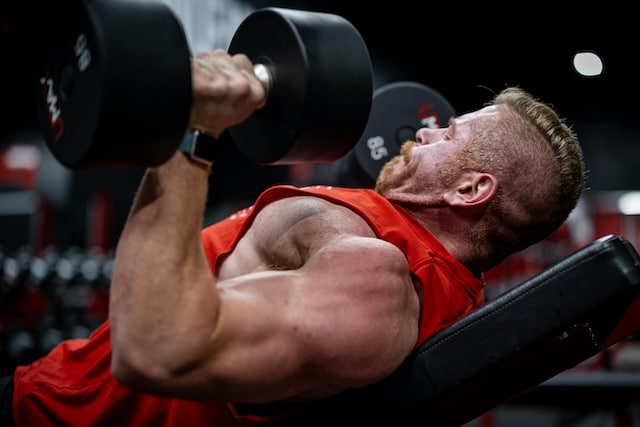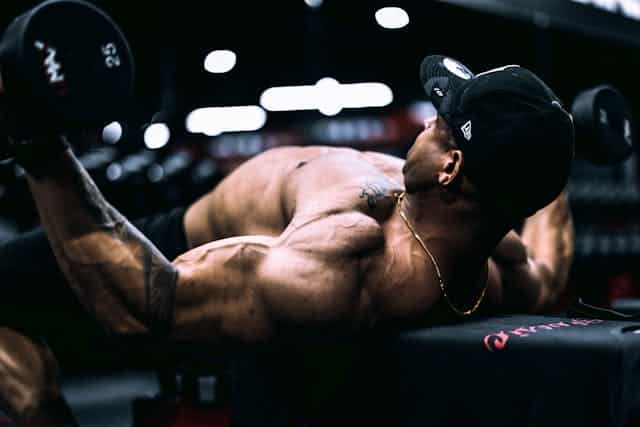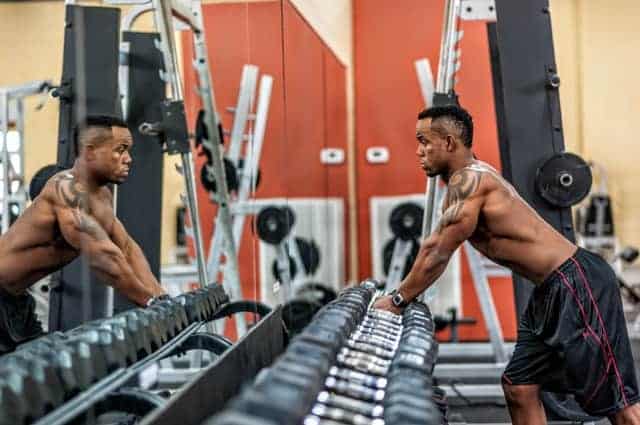The 10 Best Dumbbell Chest Exercises for Epic Chest Muscles!
When I was younger, I relied heavily on the barbell bench press, believing it was the key to building a bigger and stronger chest. While this approach gave me a lot of gains, it also led to muscle imbalances and limitations in my movement patterns that I didn’t recognize at the time.
Now, I know that dumbbell chest exercises are also essential for developing not just strong and muscular pecs, but also for building a balanced, mobile, and resilient upper body.
These exercises let your chest, shoulders, and stabilizing muscles move naturally through full ranges of motion, which is crucial for achieving a healthy, aesthetic body.
Barbell exercises and even bodyweight exercises like push-ups have their place in a well-rounded chest workout, but dumbbell chest exercises stand out because they allow for greater freedom of movement, help build muscle mass and strength, and train your body to move the weight with control and stability.
To get the most out of these exercises, I recommend using a tempo of a 3-count eccentric (lowering), a 1-second pause at the bottom, and a 1-second controlled concentric (lifting) phase.
This controlled approach gives your muscles the time they need to adapt to the stress of the exercise, helping to build both strength and power through the full range of motion.
Basic Chest Anatomy and Why Dumbbell Exercises are Effective
To understand why you need to use mutiple dumbbell chest exercises, it’s important to have a basic knowledge of chest anatomy.
The chest muscles, mainly the pectoralis major and pectoralis minor, are complex muscle groups that require different angles of resistance to be worked fully.
Using a variety of dumbbell chest exercises is crucial to ensure that all these muscle groups are activated and trained correctly, which prevents muscle imbalances and builds a more powerful and functional chest.
- Pectoralis Major: This is the larger, fan-shaped muscle covering most of your upper chest. It’s divided into the clavicular head (upper chest) and the sternal head (lower chest). Different exercises are required to target each part effectively.
- Pectoralis Minor: This smaller muscle lies underneath the pectoralis major and plays a crucial role in shoulder stability and movement.
- Supporting Muscles: Dumbbell chest exercises also engage the deltoids, triceps, serratus anterior, and stabilizer muscles, helping to build strength and mobility across your upper body.
Top 10 Dumbbell Exercises for Pecs & Chest Muscles
Dumbbell chest exercises are a game-changer when it comes to building a strong, balanced, and well-defined chest. Unlike barbell exercises that can sometimes limit your range of motion and lead to muscle imbalances, dumbbells allow for a more natural movement pattern.
This freedom helps engage not only your primary chest muscles but also the supporting stabilizers that play a crucial role in upper body strength and mobility.
For athletes, fitness enthusiasts, or anyone looking to improve their chest development, these dumbbell exercises are key to building muscle mass while also enhancing joint stability and functional movement.
In this list of the best dumbbell chest exercises, you’ll find movements that target every part of the chest to ensure well-rounded development.
Whether you’re focusing on the upper, middle, or lower chest, these exercises will help you maximize gains and build a powerful, injury-resistant upper body!
1. Dumbbell Bench Press
- Muscles Worked: Pectoralis major, triceps, anterior deltoids.
- How to Do: Lie on a flat bench with dumbbells in each hand. Lower the dumbbells slowly to chest level, pause, and then press them back up.
- Primary Benefits: Builds overall chest strength and muscle mass, while also engaging stabilizer muscles.
- Safety Tips: Keep your wrists straight and elbows slightly tucked to avoid shoulder strain.
2. Flat Dumbbell Floor Press
- Muscles Worked: Pectoralis major, triceps, deltoids.
- How to Do: Lie on the floor, with knees bent and feet flat to begin the dumbbell floor press exercise. Hold the dumbbells above your chest, lower them until your triceps touch the floor, then press back up.
- Primary Benefits: Protects the shoulders by limiting the range of motion while still strengthening the chest.
- Safety Tips: Maintain a controlled movement and avoid bouncing your arms off the floor.
3. Incline Dumbbell Bench Press

- Muscles Worked: Upper pectoralis major, anterior deltoids, triceps.
- How to Do: Set the bench to a 30-45 degree incline. Lower the dumbbells to your chest in a controlled manner, then press them back up.
- Primary Benefits: Focuses on building strength and size in the upper chest.
- Safety Tips: Do not let your elbows flare out excessively, as this can strain the shoulders.
4. Decline Dumbbell Bench Press
- Muscles Worked: Lower pectoralis major, triceps, anterior deltoids.
- How to Do: Set the bench to a slight decline. Lower the dumbbells to the lower part of your chest, pause, and then press them back up.
- Primary Benefits: Targets the lower chest to create a well-rounded pectoral development.
- Safety Tips: Avoid lowering the dumbbells too quickly, as this can put unnecessary pressure on your shoulders.
5. Dumbbell Flyes

- Muscles Worked: Pectoralis major (inner chest), anterior deltoids.
- How to Do: Lie on a flat bench with arms extended, palms facing each other. Lower the dumbbells in an arc motion until they’re in line with your chest, then return to the starting position.
- Primary Benefits: Stretches and isolates the chest muscles for better muscle definition and shape.
- Safety Tips: Keep a slight bend in your elbows to protect your joints during the movement.
6. Dumbbell Pullover
- Muscles Worked: Pectoralis major, latissimus dorsi, serratus anterior.
- How to Do: Lie on a bench with a dumbbell held above your chest. Lower the dumbbell back and behind your head, then pull it back up using your chest and lats.
- Primary Benefits: Strengthens the chest and also engages the upper back and core muscles.
- Safety Tips: Avoid lowering the dumbbell too far to prevent shoulder strain.
7. Single-Arm Dumbbell Bench Press
- Muscles Worked: Pectoralis major, triceps, core stabilizers.
- How to Do: Perform a standard bench press but with one arm at a time while the other remains extended. Switch arms after the desired number of repetitions.
- Primary Benefits: Increases unilateral strength and stability while engaging the core.
- Safety Tips: Keep your core tight to prevent your body from rotating as you press.
8. Dumbbell Squeeze Press
- Muscles Worked: Pectoralis major, triceps, anterior deltoids.
- How to Do: Press the dumbbells together above your chest and lower them down in a controlled manner, keeping the dumbbells squeezed together throughout.
- Primary Benefits: Maximizes chest activation by emphasizing muscle contraction.
- Safety Tips: Use moderate weight to avoid compromising your form and shoulder safety.
9. Alternating Dumbbell Press
- Muscles Worked: Pectoralis major, triceps, core stabilizers.
- How to Do: Hold both dumbbells at the top like in a flat bench press. Lower one dumbbell while keeping the other up, then switch arms in a controlled manner.
- Primary Benefits: Increases time under tension for each chest muscle while improving stability.
- Safety Tips: Avoid rotating your torso while performing this exercise to protect your lower back.
10. Single-Arm Dumbbell Floor Press
- Muscles Worked: Pectoralis major, triceps, core stabilizers.
- How to Do: Lie on the floor with one dumbbell in your hand, press it up from the chest position, and lower it back with control.
- Primary Benefits: Enhances core stability and unilateral chest strength.
- Safety Tips: Keep your core tight and avoid twisting your body as you perform the press.
When performed with the proper form and technique, these exercises can significantly improve strength, muscle mass, and upper body mobility while reducing the risk of injury. Incorporate these movements into your chest workout routine to maximize chest development.
Safety Tips for Dumbbell Chest Workouts
Whether you’re looking to maximize muscle growth, enhance functional strength, or improve your mobility, these dumbbell chest exercises can take your training to the next level.
Remember, building strength isn’t just about how much weight you can lift; it’s about how well you can control and move that weight.
Warm-Up: Setting the Foundation for a Safe Workout
Before diving into your dumbbell chest exercises, it’s critical to perform a proper warm-up to prevent injuries and ensure peak performance. Warming up should include exercises that focus on shoulder mobility, rotator cuff activation, and increasing blood flow to the chest muscles.
- Rotator Cuff Exercises: Include light resistance band exercises like external and internal rotations to activate your rotator cuff muscles.
- Dynamic Stretching: Use movements like arm circles, shoulder dislocates, and band pull-aparts to warm up your shoulder joints.
- Mini Band Exercises: Glute bridges, shoulder presses with bands, and banded pull-aparts can help activate supporting muscles for a balanced workout.
Cooling Down and Mobility Work
After completing your dumbbell chest workout, cooling down with stretching and mobility exercises is essential for muscle recovery and injury prevention.
Focus on static stretches that target your chest, shoulders, and upper back. Incorporate movements like the doorway chest stretch or the seated forward chest stretch to maintain flexibility and improve overall muscle health.
You can also use self-massage tools to improve blood flow and promote recovery.
Final Thoughts: Are Dumbbell Chest Exercises Better for Your Goals?
Dumbbells offer several advantages over barbells for chest exercises. They allow for a more natural range of motion, which reduces the risk of shoulder injuries and ensures both sides of your chest develop evenly.
Dumbbell exercises also activate more stabilizing muscles, making them more effective for improving muscle coordination and balance.
Additionally, dumbbells are a more versatile option for home gyms, and with adjustable dumbbells, you can easily progress as your strength increases.
Compared to barbell exercises, using dumbbells forces each side of your body to work independently, helping prevent muscle imbalances that could lead to injuries or hinder your progress!
Read Next: The Best Bench Press Programs
This website does not provide medical advice. This website site does contain affiliate links, and purchases may earn a commission.
Read my Medical Disclaimer, Review Disclaimer, and Publishing Policies for more details. Use of this site indicates acceptance of these terms.



